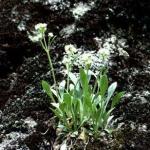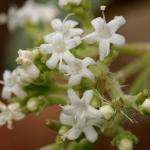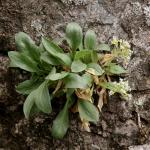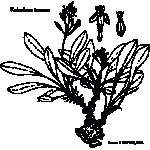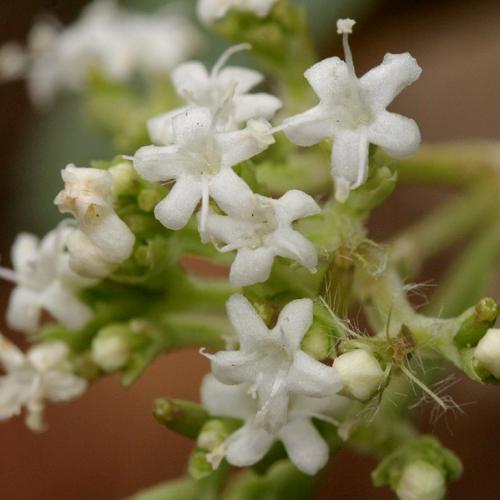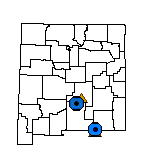Description
Perennial herb, 7-30 cm tall; caudex multiple-branched, borne on a cylindric to flattened taproot, usually with a dense cushion of old leaf bases present beneath the new growth; leaves primarily basal, undivided, elliptic to obovate-spatulate, narrowly obtuse to acute, 4-15 cm long and to 3 cm wide, glabrous; inflorescence 2-6 cm long at anthesis, later to 12 cm long, with numerous tiny flowers in clustered or paniculate cymes; flowers either perfect or pistillate; calyx 6-8 lobed, persistent, enlarging and developing short setae in fruit; corolla white, rotate, gibbous, pubescent basally without, 1.1-1.9 mm long for pistillate flowers, 3-3.8 mm long for perfect flowers; stamens exserted, usually 3; fruits indehiscent, single-seeded, narrowly elliptic to elliptic, 2-2.5 mm long, with evident adaxial ribs. Flowers April to July.
Similar Species
Valeriana texana appears in many respects to be a smaller, rather delicate, form of V. edulis. It differs in being gynodioecious rather than dioecious, with glabrous leaves that are never lobed and smooth-surfaced, narrowly elliptic to elliptic fruits rather than the ovate, often rugose fruits of V. edulis. The habit of V. texana is distinctive in the field; the larger plants expand beyond the rock cracks from which they emerge and appear cushion-like as the caudex becomes more branched and the old leaf bases accumulate.
Distribution
New Mexico, Eddy, Lincoln and Otero counties (Guadalupe, Sierra Blanca, and Capitan mountains); adjacent Texas, Culberson County.
Habitat
Shaded, moist limestone or igneous cliffs, occasionally in canyon bottoms and boulders in creeks, within piñon-juniper woodland and montane coniferous forest; 1,600-2,500 m (5,200-8,000 ft).
Conservation Considerations
narrowly endemic, but locally abundant in its range. Its remote, cliff habitats offer a great deal of protection from current land uses.
Important Literature
*New Mexico Native Plants Protection Advisory Committee. 1984. A handbook of rare and endemic plants of New Mexico. University of New Mexico Press, Albuquerque.
Barrie, F.R. 1990. A systematic study of the Mexican and Central American species of Valeriana (Valerianaceae). Ph.D. dissertation, University of Texas at Austin.
Correll, D.S. and M.C. Johnston. 1970. Manual of the vascular plants of Texas. Texas Research Foundation, Renner, Texas.
Steyermark, J.A. 1932. Some new spermatophytes from Texas. Annals of the Missouri Botanical Garden 19:389-395.

